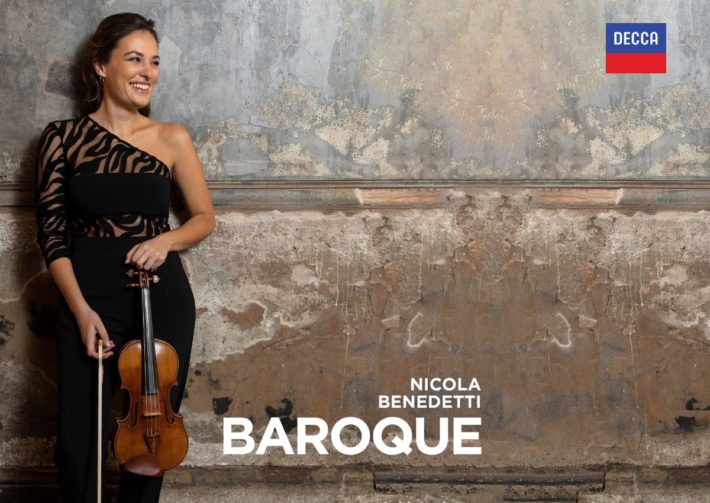In her latest release of concerti by Geminiani and Vivaldi, violinist Nicola Benedetti and the Benedetti Baroque Orchestra explore what she values as the operatic and communicative perspectives of the Concerto Grosso. She describes the misconception of the genre as mere ‘light fare’ and thus seeks to uncover its dynamic and narrative spirit.
In Geminiani’s D minor concerto, one will immediately recognize the famous La folia theme from Corelli’s Sonata Op. 5 No. 12. Geminiani’s arrangement of the theme and variations for a larger ensemble adds a robustness that makes this an exhilarating listen. The highly virtuosic first movement is an impressive effort in collaboration: Benedetti and the ensemble are on point with impeccably synchronized handoffs and articulation. The excellent clarity also helps bring out interesting textural permutations. Listen, for instance, to the final variation that starts at 2’39” and you’ll hear the melodic line move from the assertive solo violin to the bass, where it assumes an even more furious presence.
The second and third movements have their lively moments, but the variations here are a little more diversified in pacing and personality. The musicians, in turn, highlight more far-reaching characters ranging from elegant and dancelike to even contemplative. The slowest variation, for one, that appears toward the middle of the third movement (track 3) is a series of sliding dissonances and suspensions. Careful attention is paid to their richness through skilled voicing and harmonic calibration.
Related Classical Music Reviews
- Double Review: Chopin Piano Concertos – Grosvenor, Yundi
- Review: Chopin – Complete Nocturnes – Jan Lisiecki
- Review: Four Recent Chopin Albums (2021)
Though less famous than some of its other cousins, Vivaldi’s E-flat Major Concerto is an excellent example of Benedetti’s description of the Concerto Grosso as multifaceted. While invigorating, it’s also commanding. The first movement (track 7) features the soloist and ensemble as two distinct characters in conversation: Benedetti’s tone is clear and crystalline (perhaps a bit too much in some places that could use smoother phrasing). However, the runs, arpeggios, and trills nicely bring out a plucky buoyancy. The orchestra has a pleasing depth and roundness throughout: it not only complements but even helps tone down Benedetti’s crisp approach ever so slightly for a perfect overall balance. And of course, the harpsichord ties everything together, supporting the rhythm of the low strings but also bringing a distinctive timbre that stands out from the string component.
The Adagio (track 8) is so beautifully done that one wishes it were not so short. It is a distinct contrast from the opening movement, and the performance shows the interesting transformation of character. The ensemble’s resoluteness now becomes gentle dignity in its swaying dotted rhythms. Benedetti, too, plays right into Vivaldi’s long and lyrical lines with an added spontaneity that diverges from the precise rhythms we heard prior. The conversation is still present, but perhaps in a more intimate light: if we listen closely enough, we can hear the interchanges between violin and lute that add a fine layer of nuance.
The operatic element surfaces in a convincing rendition of the B Minor Concerto (tracks 10-12). As yet another dramatic selection, we hear a determined, almost stormy ensemble against which the soloist’s lines come up, expressive and imploring. The soloist perhaps stands out the most as an ‘individual’ in this particular concerto, which makes complete sense – the imaginative interpretation does not make it all hard to envision Benedetti’s description of it as a “love dispute gone wrong.”
The sound engineering does well to bring out the heftiness of the ensemble and the brilliance of the solo violin but never in a way where there is competition. Benedetti and her ensemble are indeed successful in their quest to bring out the vibrance of the Concerto Grosso. The selections and interpretations are such that listeners will find themselves fully involved and, in the best moments, captivated. What’s even better is that the recording as a whole emphasizes that the genre is not so much about glorifying a soloist as it is about creating a solid partnership. This is a top-notch effort from all the performers, one that will be sitting on my shelf waiting for multiple listens to come. Enthusiastically recommended.

“Baroque”
Geminiani: Concerto grosso after Corelli, No. 12 in D minor ‘La Folia’
Vivaldi – Violin Concertos RV 211, 257, 386, 583
Nicola Benedetti – Violin
Benedetti Baroque Orchestra
Decca Classics, CD 4851891
Recommended Comparisons
Read more classical music reviews or visit The Classic Review Amazon store
Follow Us and Comment:
Get our periodic classical music newsletter with our recent reviews, news and beginners guides.
We respect your privacy.









